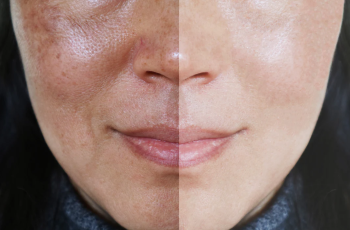
Skincare Benefits of Malic Acid- Why is Malic Acid Good for Skin?
An apple a day keeps the doctor away, or so the famous saying goes! Well, apples aren’t only a healthy snack, the acid found in them is also wonderfully beneficial for the skin. Malic acid is a member of the Alpha Hydroxy Acid family and admittedly this acid is not as popular or well known as others like, lactic or hyaluronic. But it delivers incredible results for the complexion. Find out more about this acid in this guide.
What is Malic Acid?
You will find that malic acid is naturally produced in the body and aids movement by converting carbohydrates into energy. Without malic acid, getting from A to B will be significantly more difficult.
For cosmetic malic acid is derived from fruits such as apples and pears. It is considered part of the group of chemical exfoliates called Alpha Hydroxy Acids. Out of all the AHAs, malic acid is the least studied but the research carried out has shown this acid to hold many beneficial properties be it for a health supplement to skincare.
Having first been isolated from apple juice in 1785, malic acid has been used for centuries in the food and drink industry to give the products a tart taste. Fast forward to present times and you may be surprised to hear that malic acid appears in many skin and hair care products such as:
Shampoos
Body lotion
Nail treatments
Acne treatment
Anti-ageing products
And many more
Malic acid is used by skincare professionals mainly as part of chemical peels due to the fact that the acid is celebrated for its ability to brighten the skin and smooth uneven texture.
Much like its fellow AHA, malic acid stimulates the exfoliation of skin by interfering breaking down the cohesive bonds of dead epidermal cells. As the bonds are broken down and dead skin cells are removed, your complexion will appear brighter and will also be less prone to forming blemishes.
Another way malic acid is used is to take it orally using supplements or tonics to help with syndromes such as dry mouth, carotic pain and tiredness. The dosage of the acid needs to be taken into consideration, but more on that later on.
What are The Top Benefits of Malic Acid
We have already covered some of the benefits of malic acid briefly and now we will go into more detail of the top benefits of malic acid and what it can do for you and your skin.
Malic Acid Can Prevent Breakouts and Blemishes
Malic acid is a key ingredient to the prevention of breakouts, such as spots and blackheads. With the exfoliating properties of the acid able to sweep away any dead skin cells that can lead to a dull-looking complexion. A build of these cells, as well as debris, bacteria and excess sebum, leads to spots and other blemishes forming. By working its way into the lower layers of the skin malic acid is able to clear the pores and rid the face of dead skin cells. You will also find that pigmentation, scarring and other skin concerns normally associated with breakouts will be treated.
Malic Acid Restores pH Balance and Hydrates the Skin
Similar to hyaluronic acid, malic acid is a humectant. By that I mean it is able to retain moisture and keep your skin hydrated. Great for anyone suffering from dehydrated skin which is often mistaken for skin that is showing the first signs of ageing.
Malic acid is often used as an ingredient in cosmetics due to its pH balancing properties. When the pH levels of your skin are imbalanced, your skin’s protective barrier becomes destabilised thereby causing your skin to become more prone to dryness, irritation and breakouts. Unlike other acids, malic acid has a unique ability in maintaining a balanced pH for a longer duration of time.
Those suffering from eczema should also note that malic acid can help calm and reduce irritation and hydrate the skin. Using malic acid for skin conditions requires a great deal of consideration as both its short and long-term impact is unknown.
Malic Acid Can Help with Anti-Ageing and Pigmentation
Malic acid promotes high skin cell turnover rate, resulting in the process of shedding layers of old skin cells is quicker than the usual 30-day cycle this, in turn, leads to:
Fewer visible fine line and wrinkles
An even skin tone
Smoother texture to the skin
Skin appearing firmer and plumped
Less blemishes to the complexion
As we age, the production of collagen decreases in our bodies and this leads to our skin losing its firmness and elasticity. Using higher concentration of malic will also allow the acid to work further down the layers of skin and increase the formation of collagen. With collagen production receiving a helping hand from malic acid, skin appears firm, plumped and youthful with the signs of ageing reduced significantly.
As for pigmentation of the skin, malic acid speeding up the turnover of cells results in dark marks and pigmentation becoming less visible over time. One important factor to remember is that with the new skin cells being on show results in skin sensitivity to the sun’s UV rays. Applying a high SPF is an important part of your daily skincare routine.
During a study in 2013 a group of people who suffer from Melasma. The study involved the participates to use a daily skincare routine of vitamin C and malic acid and monitored the effectiveness of these ingredients on their melasma. After 26 months of follow-up studies, both ingredients were determined to have short term benefits.
How To use Malic Acid and the Correct Dosage
For skincare products, such as cleansers, creams and others the level of malic acid is lower and diluted within the formulations and can be used daily for up to 60 days. Other conditions, such as fibromyalgia syndrome can be treated twice daily for 6 months by taking a product called super malic acid which is magnesium and malic combined.
The appropriate dosage for malic also depends a lot on how you are using the ingredient be it in supplement or topical. Other considerations would be your age, gender and medical history.
What Are the Side Effects of Malic Acid?
You will find that with some AHA there are some side effects to remember, here are the main ones that have been experienced when using malic acid.
Orally:
Headaches
Diarrohea
Nausea
Allergic reactions
Topically:
Itching
Redness
Increased sensitivity sun exposure
Introducing an AHA into your skincare routine is something that can’t be taken without consideration and of course a patch test. If you feel as though your skin will rejoice if you begin to use this AHA then by all means find the right dosage and product for you and your skin. If not, best to stick to the apples, and if they are in a pie, even better!
Are you wanting to find another AHA that will give your skin a healthy glow without too much to worry about why not check out our guide on hyaluronic acid.


